With such a large variety of CB radios available on today’s market, it is always good to find one that is equipped with the right amount of “bells and whistles”…..enough to satisfy a handful of desired features but not so many that half of them would never honestly get used. It seems that Midland’s 1001LWX radio offers just that with a 40 channel AM radio and a 7 channel Weather Band receiver. And the price….well, that won’t break your project budget either.
Midland is a consumer and commercial grade radio manufacturer that has 50 years of radio production behind them. I’ve known a few 2-way technicians that have serviced some of the Midland commercial radios and have had good things to say about them. So I looked forward to giving this one a try to see how it performed.
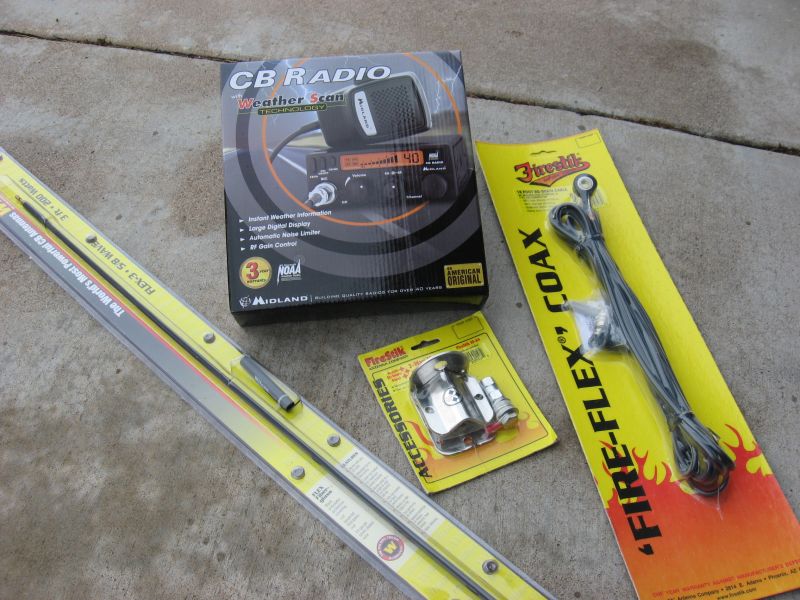
I contacted the folks at Right Channel Radio and soon had the Midland 1001LWX in hand along with a 3′ Wilson Flex 5/8 wavelength slim style antenna, a Firestik mount, and a length of Firestick coax to hook everything up. I’ve dealt with RCR before and so I was not worried about what was going to show up. When I opened the package, I knew everything would be there. (and it was)
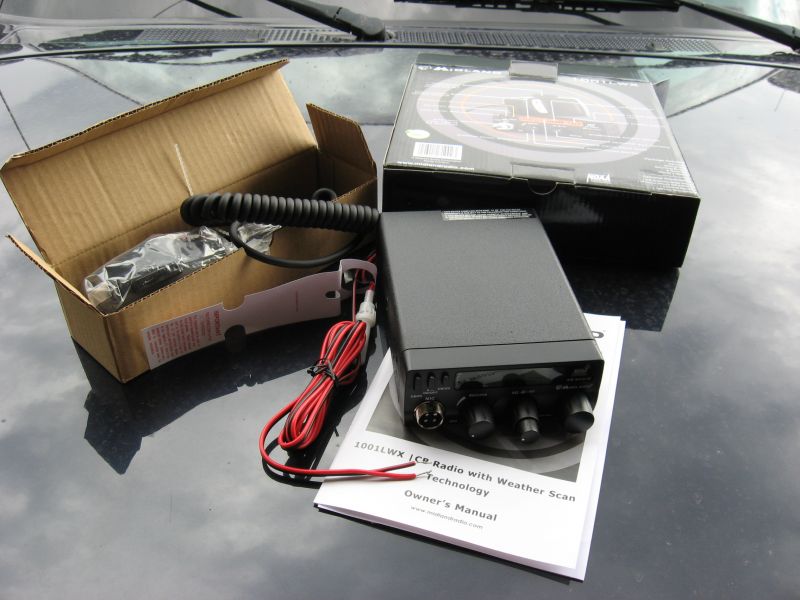
In today’s vehicles, unused space is usually at a premium. The smaller your 12 volt powered device is, the easier it is to find a temporary or permanent spot for it. The carbon free footprint of this green radio (sorry, just had to throw that in as it seems to be all the craze these days) measures in at about 5″(W) x 6.5″(D) x 1.5″(H). That isn’t too bad for a CB radio. Shrinking the size down much more than that can leave you squinting to see the tiny markings on the front panel and its display. These aging eyes appreciate not having to put on my glasses just to read the labels over the controls.
The 40 channel, 4 watt radio, comes with a coiled cord microphone, microphone hanger, power cable, and a mounting bracket. The receiver provides a .8uV sensitivity at a 10db signal to noise radio. Now .8 micro-volts isn’t big news to write home about…..a good ham radio receiver will be down in the .1 something uV range…..but you won’t be paying just $60 for it either. Speaking of the price, I also noticed that Midland has a $10 rebate going on until the 9/30/2010….so now we’re talking about a $50 radio. That works no matter how you cut it!
Front panel controls give you most everything you need: Squelch, RF Gain (and it really does work), Audio volume, Automatic Noise Limiter (ANL) switch, Channel selector, CB/PA switch, and a CB/Weather mode switch. The mic attaches to the front panel via a screw on multi-pin connector. A sizable LCD meter shows signal strength (transmit and receiver), operating channel, and indicators for the other switches. The rear panel offers a standard SO-239 coax connector, power cable (not detachable), External speaker jack, and a Public address (PA) speaker jack. A U-shaped mounting bracket secures the radio to the selected mounting surface.
So….enough about the radio for now…time to get it installed.

This was the first time I used the Firestik FireRing coax with the mounting ring molded into the end of the cable. It makes for a handy connection method since there is no exposed coax for moisture and such to cause problems. The typical PL-259 RF connector that screws onto the SO-239 antenna mount is not waterproof. Those can be made quite water resistant with two layers of rubber tape over wrapped with standard electrical tape. I didn’t have to do that with this setup so that was one less thing to do. I know lots of folks don’t take the extra couple of minutes to waterproof their coax connections….and they will fail on the trail, sure as Jeeps roll over when you least expect it.
Just so everybody knows, not all of my projects go off like a “text book” perfect installation. I have my share of head scratching issues too, just like other folks. I had one on this project…..so let me explain here with the help from a couple of photos.
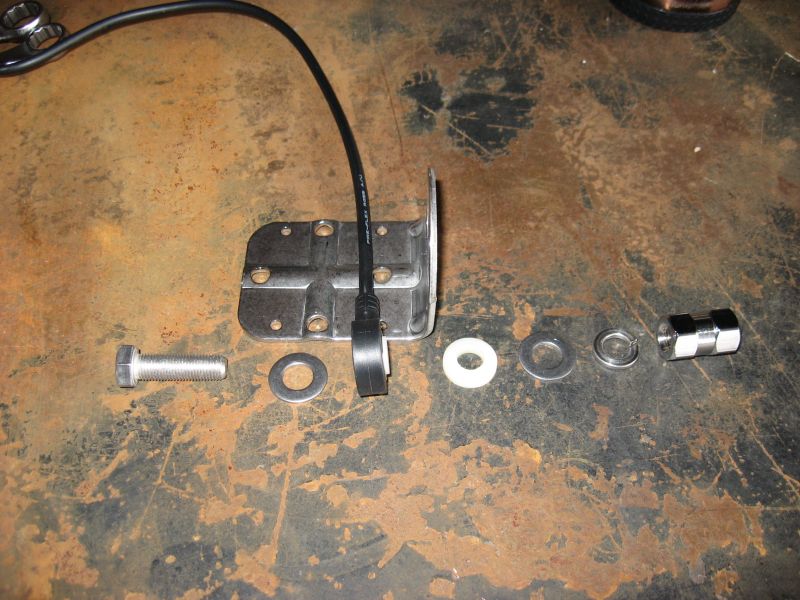
Here is the assembly order (or stacking order if you prefer) for the mounting bracket, antenna mount, and coax. The bolt goes through the metal flat washer, through the FireRing coax, through the hole in the mounting bracket, through the insulated shoulder washer, then another flat washer, a split washer, and finally into the thread antenna mounting stud. Note the orientation of the FireRing coax and the small white area on its right.

Here is a close-up of the end of the FireRing coax that attaches to the antenna mounting connector. Note the white insulator that protrudes from the center of the ring. This is the insulated shoulder washer that is built into the ring and prevents the center conductor of the coax from contacting the antenna mount and thus shorting the RF signal to ground. (not good for your CB radio nor your transmission distance) This shoulder fits into the hole in the mounting bracket and so is self centering in that respect. With the bolt going through the center of it, the bolt is insulated from the metal mounting bracket.
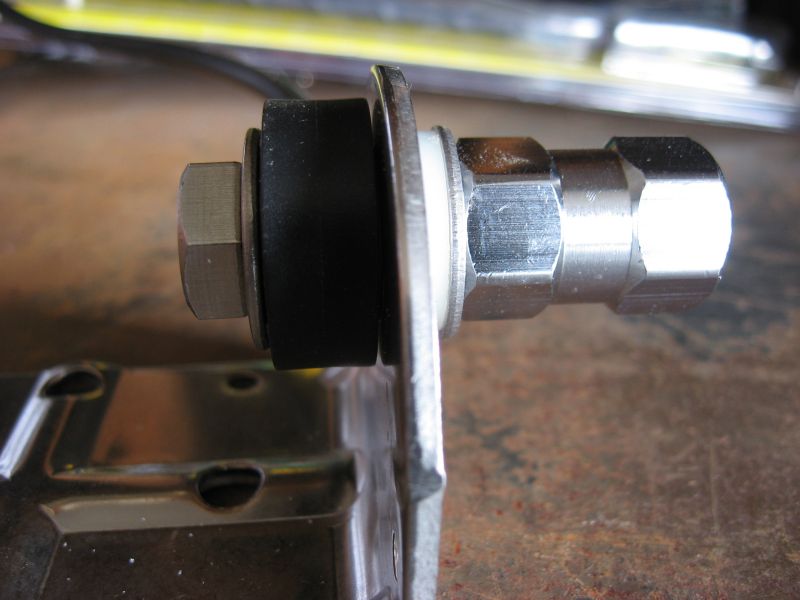
So….with everything lightly tightened, the antenna stud should be solid on the mount. Mine wasn’t. Note the gap between the FireRing and the mounting bracket. That should NOT be there. The antenna mount was basically loose in the mounting bracket.
Remember, there was another insulated shoulder washer on the top side of the mounting bracket. It keeps the antenna stud from touching the mounting bracket and it helps keep the mounting bolt coming up from the bottom of the bracket insulated as well, just like the shoulder washer on the FireRing coax. However….the shoulder washers were pulled towards each other when everything was being snugged down….and they met before all of the slack was taken out of stacked components. So, things ended up being loose and that was not good!
What to do?

That nylon shoulder washer on the top side of the mounting bracket was no match for a coarse file from my tool box. I took .030″ (ok, so I got anal and actually measured it) off of the shoulder side of the washer. There was still a shoulder left but now, when everything was tightened together, there was enough clearance for the two shoulder washers to come together inside of the bracket mounting holes without hitting each other. I still had a well insulated bolt through the middle of the mount’s hole and it was night and snug, the way it should have been. I would venture a guess that someone at Firestik put the wrong thickness shoulder washer in the package….or the vendor they get the washers from had a quality control issue and no one caught it.
So….the important thing is that this was entirely “fixable” by me and I didn’t have to wait on getting a replacement part. It took about 3 minutes with the file and I was back on track with the installation. Hey, resolving it yourself isn’t such a bad thing, especially when you don’t have to wait until next weekend to get it finished! OK, on with the installation.
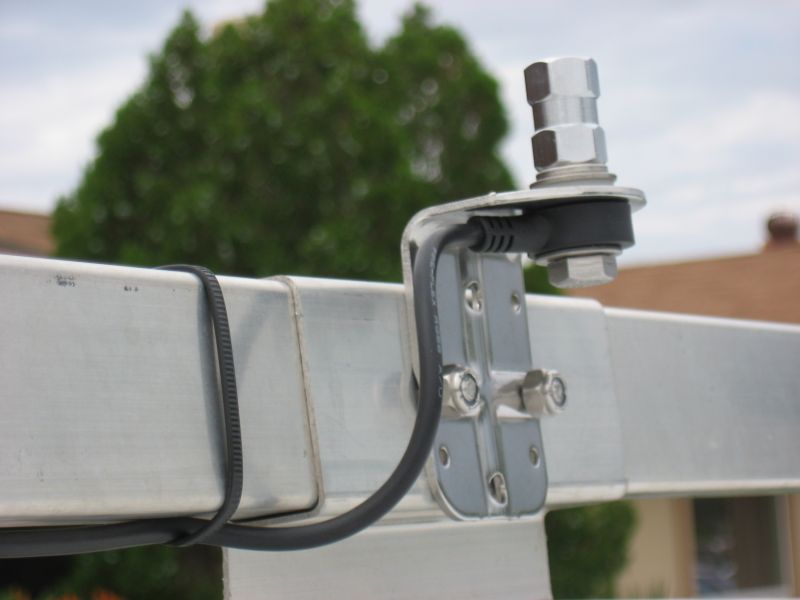
I used half of the Firestik SS64 stainless steel mount. Since my mounting point was a bit thicker than what is commonly used, the supplied stainless steel bolts weren’t quite long enough. The local ACE Hardware store had the longer 1/4×20 stainless bolts I needed. I usually keep some in the nuts and bolts box but I didn’t have them in the proper diameter.
Midland 1001LWX CB Radio Installation & Review
As I mentioned before, finding a suitable spot in the vehicle to safely mount a radio can sometimes be a challenge. After I kicked around a number of ideas, I decided on putting it center stage right behind the manual transmission’s stick shift. I grabbed a ruler and made sure I would have the necessary clearance with the front seats in their usual position.

I won’t even try to explain this. Trust me when I say it was made from some scrap plywood I had in the garage, a few small diameter wood screws, and a tube of Elmer’s glue. The clamps and bungee cord are there to keep things in the proper position while the glue dried. After it was fully assembled, a can of black spray paint, left over from the last Jeep fender flare touchup, was pressed into service. Most of my handy work would be hidden under the seat so I wasn’t too worried about the overall looks.
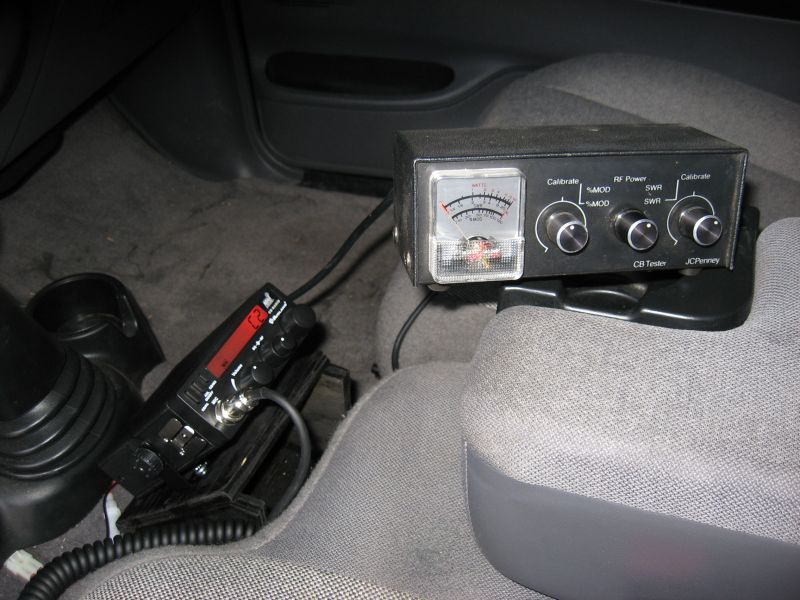
OK….you can see my mounting platform under the radio. it is just a plywood shelf, so to speak, sitting at a 45 degree angle. The bottom board that the shelf is attached to extends back underneath the seat. The transmission hump and seat brackets causes it to become wedged in place. It works for me!
I grabbed my 30 something year old JC Penney SWR meter and installed it between the radio and the antenna. Hey, don’t laugh….that meter works very well and has been used on more antenna adjustments than you might possibly imagine. There was a time I use to keep it in the TJ just to help out the folks that showed up for the group trail rides. Since I already have a write-up on adjusting the CB antenna, I won’t cover it again. You can find details on how to adjust the antenna here.
Note the radio’s display in the above photo. It shows “C2” which means it is on weather channel #2. I can get a couple of the weather channels at my house. To get the weather, just push the CB/WX button on the front panel and the radio will switch from CB mode to NOAA weather channel mode. Here is a short (~20 seconds) sound byte (hey, it is a digital recording) of what the synthesized weatherman sounds like. My recording isn’t the best so don’t worry about nominating me for a Grammy (just in case you were considering it).

A close-up shot of the radio on it’s hand crafted, low carbon footprint, high speed, low drag mounting platform. I had the microphone keyed and the SWR meter indicated a solid 4 watt output.
I liked the operation of the radio. Both the squelch and RF gain controls have very usable range. You’ll find the RF gain especially handy when you are on the trail with a group of folks and you are all close to each other. Decreasing the RF gain control will prevent those radios that are very close from over loading the front end of the radio and causing poor reception quality. If you are in a busy area, say Moab or some other popular off-road location, backing down the RF gain will reduce or eliminate the signals from other groups that may be nearby.
The automatic noise limiter (ANL) works as designed. It helps cut the ignition and/or fuel pump noise that is commonly encountered in vehicles. Of course, just like all ANL equipped radios, you will loose some sensitivity. Try it in the on and off positions and see which works best for the situation at hand.
So….that is about it for the Midland 1001LWX, at least for now. I’ll report back again when I get some more air time with the radio. I did a quick signal check and got a solid copy from another operator that was several miles away…..that works for me in a metropolitan area. It will be better out on the road or trail with a clear signal path.

